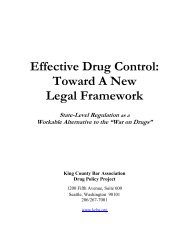RACE AND THE ENFORCEMENT OF DRUG DELIVERY LAWS IN ...
RACE AND THE ENFORCEMENT OF DRUG DELIVERY LAWS IN ...
RACE AND THE ENFORCEMENT OF DRUG DELIVERY LAWS IN ...
You also want an ePaper? Increase the reach of your titles
YUMPU automatically turns print PDFs into web optimized ePapers that Google loves.
ut only 89 for methamphetamine, ecstasy and powder cocaine combined in the<br />
1999–2001 period. Because the vast majority (74 percent) of the serious drug<br />
delivery arrests from 1999–2001 involved crack cocaine, the majority of those<br />
arrested were black. The SPD’s overwhelming focus on crack cocaine was thus a<br />
primary cause of racially disparate arrest rates in Seattle.<br />
2005–2006 SEATTLE <strong>DRUG</strong> <strong>DELIVERY</strong> ARRESTS<br />
The analysis of more recent arrest records indicates that these patterns—the<br />
over-representation of blacks among drug arrestees and the dominance of crack<br />
cocaine arrests relative to arrests involving other serious drugs—has not<br />
changed. 86 A clear majority (74.1 percent) of the purposeful delivery arrests that<br />
took place during the four-month sampling period from 2005 to 2006 involved<br />
(only) crack cocaine. During this time, the SPD made 209 purposeful delivery<br />
arrests involving (only) crack cocaine, but only 24 involving powder cocaine,<br />
methamphetamine, ecstasy or heroin (see Figure 7).<br />
80%<br />
70%<br />
60%<br />
50%<br />
40%<br />
30%<br />
20%<br />
10%<br />
0%<br />
Figure 7. Purposeful Seattle Drug Delivery Arrests by Drug,<br />
1999-2001 and 2005-2006<br />
Meth Heroin Ecstasy Powder<br />
Cocaine<br />
Crack<br />
1999-2001<br />
2005-2006<br />
Source: Seattle Police Department incident reports.<br />
Note: Another 7.1 percent of all purposeful drug delivery arrests involving serious drugs<br />
involved crack cocaine and another serious drug.<br />
86<br />
All narcotics-related Seattle Police Department incident reports for the months of April and<br />
May 2005 and 2006 were provided to attorneys from The Defender Association and the ACLU<br />
Drug Law Reform Project and made available for analysis. The results presented here are<br />
based on an analysis of this four-month sampling period. Incidents in which no arrest was<br />
made or where the arrest location fell outside Seattle city boundaries were not included in the<br />
analysis.<br />
48

















